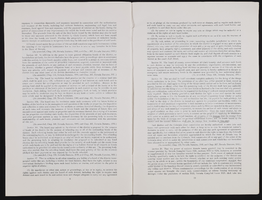Search the Special Collections and Archives Portal
Search Results
Alan Cummings Research Files
Identifier
Abstract
The Alan Cummings Research Files (1974-2004) are comprised of research files compiled by Cummings, an elementary school teacher for the Clark County School District (CCSD) in Southern Nevada. The files represent Cummings's work to persuade the Teacher's Health Trust, the employee benefit plan for the school district, to consider domestic partnership benefits for CCSD educators and administrators. Materials include personal correspondence, newspaper clippings, magazines, and court cases.
Archival Collection
Harriet Barlow oral history interview
Identifier
Abstract
Oral history interview with Harriet Barlow conducted by Elsha Harris-Tolanda on April 27, 2015 for the African Americans in Las Vegas: a Collaborative Oral History Project. In this interview, Barlow discusses her personal history and growing up in Robbins, Illinois. She talks about her education, discrimination in schools, and the process of school integration. Barlow then recalls her first impressions of Las Vegas, Nevada and her employment at the University of Nevada, Las Vegas. Lastly, Barlow describes going through graduate school as an African American and explains why conversations about race relations can be difficult.
Archival Collection
Charles Roland oral history interview
Identifier
Abstract
Oral history interview with Charles Roland conducted by Claytee D. White on August 16, 2012 for the African Americans in Las Vegas: a Collaborative Oral History Project. Roland begins by describing why his family moved to Las Vegas, Nevada in 1952 and attending Las Vegas High School. He discusses the African American community in Las Vegas, working in a restaurant called Sill's Drive-In, and his father, who opened the Hamburger Heaven restaurants. Roland also discusses race relations in Las Vegas prior to integration, the Binion family, and how Las Vegas has changed.
Archival Collection
Rick Peppers oral history interview
Identifier
Abstract
Oral history interview with Rick Peppers conducted by Claytee D. White on July 06, 2016 for the Boyer Early Las Vegas Oral History Project. In the interview, Peppers describes his childhood in Exira, Iowa and moving to Blue Diamond, Nevada in 1962. He explains working in various positions at the Blue Diamond Mine to ensure employment stability. Peppers shares stories about how the mine company's ownership of Blue Diamond affected the town. After transitioning into security jobs, he explains working through the Teamsters Union at the Aladdin Hotel and Casino, and then working forty-six years at Caesars Palace Hotel and Casino in Las Vegas, Nevada.
Archival Collection
Helen Smith oral history interview
Identifier
Abstract
Oral history interview with Helen Smith conducted by Claytee D. White on February 20, 2007 for the Boyer Early Las Vegas Oral History Project. In this interview, Smith discusses her personal history and moving to Las Vegas, Nevada in 1956. She then talks about her employment at Southern Nevada Memorial Hospital and the change to University Medical Center (UMC). Smith recalls an air conditioning business she co-owned with her husband at the time, and the activities she did as a member of Daughters of the Nile, a women's community service organization. Lastly, she discusses education and the general changes in Las Vegas.
Archival Collection
Susan and Holly Carratelli oral history interviews
Identifier
Abstract
Oral history interviews with Susan and Holly Carratelli conducted by Dennis McBride on June 24 and 26, 1999 for the Las Vegas Gay Archives Oral History Project. In the interviews, Susan and Holly recall first meeting during the planning for the 1994 National Coming Out Day event in Las Vegas, Nevada. They discuss what they value in a relationship, their past relationship experiences, and their involvement with the Gay and Lesbian Community Center and Metropolitan Community Church. Other subjects they cover include their marriage, anecdotes about living together, having children, their daily routine, and conflicting inter-community perceptions between gay men and women in Las Vegas.
Archival Collection

Film strip of individuals or Hoover Dam construction, image 007: photographic print
Date
Archival Collection
Description
Image
Stephen Nasser Papers
Identifier
Abstract
The Stephen Nasser Papers (1992-2018) mainly contain letters written from school children to Nasser who travels to schools, churches, and organizations around Las Vegas, Nevada to share his story of surviving the Holocaust during World War II. Materials in this collection document his captivity in various prison camps and includes photographs, awards, and newspaper clippings. Also included are speeches given by Nasser and book reviews and a teacher's guide of his book My Brother's Voice written by students of Dixie College, St. George, Utah. This collection includes a copy of
Archival Collection


